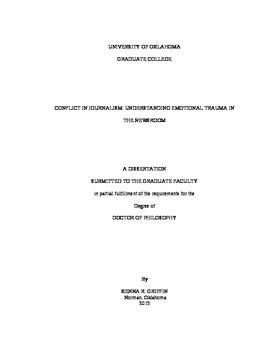| dc.description.abstract | Journalists are exposed to emotional trauma as a result of their work and some of them suffer trauma symptoms following that exposure. Despite this understanding, most journalists and their employers do not view journalism as a trauma-prone profession, and training for coping with emotional responses of exposure to traumatic events rarely is provided or accepted when it’s made available. Journalists’ professional identities are one reason they refuse to recognize, admit or seek treatment for emotional trauma. Journalism professional values result in some journalists experiencing a conflict between their professional and personal identities. This conflict is further exacerbated for some journalists by the organizations for which they work. The newsroom organizational climate does not support journalists with policies, practices and procedures related to open communication, training, support, safety, or mental health, all of which are critical in helping them effectively cope with trauma or manage exposure to traumatic events.
This study creates a better understanding of journalism and trauma by connecting three areas of potential conflict—trauma exposure and symptoms, professionalism and organizational climate. The study’s initial purpose was to extend the understanding of journalism and trauma by gathering information from a national sample of professional journalists about the types of trauma they have experienced and the symptoms they suffered. The study then measured how journalists’ professionalism may play a role in their willingness to admit to suffering emotional trauma or to seek help for it, and how professionalism may affect journalist’s views of work-related trauma, in general. Finally, the study tested the role of the newsroom organizational climate in preparing journalists for trauma exposure and providing them with support afterward.
This study found that journalists are exposed to trauma in their work more frequently than the general population is exposed in their lifetimes and they report trauma symptoms comparable to those in high-stress occupations like first responders. This study also found that there is a relationship between journalists’ professional values and the likelihood that they will experience trauma symptoms, and that journalists adhere to journalistic professional values like the service role to bear witness for the public, a commitment to truth and objectivity, even when those values create a conflict for them following exposure to traumatic happenings. Finally, this study found that there is a relationship between the organizational climate in which journalists work and the likelihood that they will experience emotional trauma. It found that journalists feel supported by their supervisors, who they think care about their well-being. However, it also found that these same supervisors do not provide journalists with the information, training or support necessary to cope with trauma exposure and its aftermath, even though these components of organizational climate lessen the likelihood that the journalists will experience trauma symptoms.
This dissertation found that journalists are exposed to trauma in their work near the high end of what previously was thought and similar to that of crisis workers, confirming the severity of this issue in journalism, and contributing to the understanding of the types of traumatic events journalists are exposed to and the impact of that exposure. This study also extended the understanding of journalism professionalism in relation to trauma by considering how journalists’ professional identities may impact how they think about trauma in their work, beginning to create an understanding of the professional conflict that trauma exposure and suffering creates when journalists deny it can happen to them. Finally, the study revealed the disconnect between journalists’ thinking about their organizations and managers in relation to the potential negative impact of trauma exposure in their work. These findings contribute to the understanding that news organizations are not providing employees with the information and training they need to help maintain their emotional well-being while performing their jobs. | en_US |
